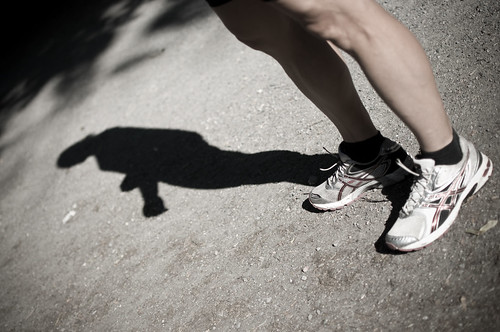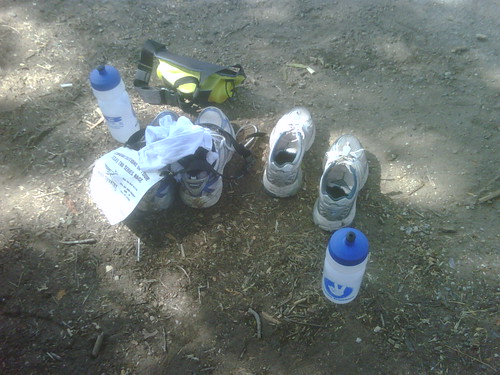 In the previous post, I had listed and described my top 5 endurance sport training errors. It only took a few minutes to realize that there are easily a “second five” errors that are begging to be included. How could I deny them the opportunity of fame?
In the previous post, I had listed and described my top 5 endurance sport training errors. It only took a few minutes to realize that there are easily a “second five” errors that are begging to be included. How could I deny them the opportunity of fame?
In my experience clinically and as a coach, I am convinced that these 10 factors either increase the risk of injury or prevent the athlete from attaining his/her performance goals. Address these factors, and you can effectively optimize your workouts while removing the vast majority of limiters in your endurance sport training.
So without further adieu, here are five more endurance sport training errors to consider, followed by the complete top 10 list.
 I have spent many years as a physiotherapist fixing injured athletes, especially runners and triathletes, and have heard many a tale of running injury woe. On further analysis, most of these tales of injury have a common theme.
I have spent many years as a physiotherapist fixing injured athletes, especially runners and triathletes, and have heard many a tale of running injury woe. On further analysis, most of these tales of injury have a common theme.
When you review the sports sciences research on running injuries, you find that there is just one factor, the common theme, that correlates directly with the onset of these problems.
Is it “biomechanical mal-alignment”, with issues such as leg length discrepancies or excessive foot pronation? No.
Is it any specific type of running shoe (or lack thereof)? No.
The one factor that correlates directly with the onset of running injuries is, imagine this, training.
“Training error” is common in most endurance sports. Sad as that may be, there is a beauty in knowing this. Why? Because training can be readily adjusted and optimized. Adjust the training plan – and minimize the risk of injury. And better yet, optimize your performance in the meantime. Now that is a “win-win” if ever there was one.
Here are the top 5 errors that I have found in the training plans of endurance sport athletes.
 I have always maintained that more often than not, a real-life story can indeed be more mind-twisting than any piece of fiction. Just when you thought you’d heard the craziest or most incredible tale, something else pops up to put everything else to shame. Who needs fiction when we have reality? I think that Rhubarb Ruminations should have that as it’s byline - “where truth is stranger than fiction”!
I have always maintained that more often than not, a real-life story can indeed be more mind-twisting than any piece of fiction. Just when you thought you’d heard the craziest or most incredible tale, something else pops up to put everything else to shame. Who needs fiction when we have reality? I think that Rhubarb Ruminations should have that as it’s byline - “where truth is stranger than fiction”!
Here are a few more stories that bring true meaning to that phrase.
1. Consider this – there is a possibility (albeit a slim one) that both Sarah Palin and Donald Trump could run for the nomination as the Republican Party’s presidential candidate. If I ever thought that “Alaska 2008” sounded downright bizarre, add “Atlantic City 2012” to the mix. Palin and Perry, or Trump and the Celebrity Apprentice? No, the Presidency is not turning into just another reality TV show, or at least let us hope that is not the case. It could be an interesting battle of hair care products as we head towards the 2012 election. Pantene, Suave, and Rogaine could all become corporate sponsors.
 The United States is currently faced with an antiquated, gatekeeper-driven approach to health care that best exemplifies defensive behaviors, territorial debates and turf battles more so than “patient-centered care”. While lobbyists throw millions of dollars at legislators in order to protect the sacred turf of gatekeepers, the patient suffers.
The United States is currently faced with an antiquated, gatekeeper-driven approach to health care that best exemplifies defensive behaviors, territorial debates and turf battles more so than “patient-centered care”. While lobbyists throw millions of dollars at legislators in order to protect the sacred turf of gatekeepers, the patient suffers.
There are many lessons in patient-centered health that can be learned from the global village. The rest of the world has quietly moved forward and embraced direct access to physical therapy as an effective means of enhancing patient-centered care and in increasing access to appropriate care. They have done so with great success. You don’t have to go any further than our neighbor to the north to find one of the world leaders in direct access to physical therapy.
Let’s examine what the international perspectives on direct access to physical therapy, what can be learned from these cumulative international experiences, and what the limiters are in this country.

On that fateful day in 1954, there were just 1,000 people in attendance at the University of Oxford running track. At the time, Bannister was a 25 year-old medical student. Today, he is Sir Roger Bannister, neurosurgeon.
The physical barrier that was broken that day was significant. People wondered if the 4 minute barrier would ever be broken. Was it possible physically? When he crossed the finish line with a time of 3 minutes, 59.4 seconds, not only did he break through a perceived physical barrier, but he broke through a tremendous psychological barrier as well.
One man, four minutes, and suddenly there were new perceptions on the limits of human performance.
 For those in the US that didn’t know or, perhaps more accurately, really didn’t care – there was a federal election held in the country north of the US on Monday, May 2.
For those in the US that didn’t know or, perhaps more accurately, really didn’t care – there was a federal election held in the country north of the US on Monday, May 2.
As luck would have it, having an election just three days after a Royal Wedding and one day after Bin Laden’s death didn’t exactly guarantee very much coverage in the American newspapers. Not that a Canadian election would ever gain much news traction in this country anyways.
Living just one mile from the state of New York, I grew up watching US political coverage on TV. Let’s face it - Canada has just one-tenth the population of the United States, and at times about one-tenth the level of news excitement and political intrigue. Nonetheless, let’s take a look at five fun facts about the current Canadian political climate and how similar (and different) it is compared to the politics south of the 49th parallel (the line of latitude that serves as the main border between Canada and the United States).
 Health care has a huge impact on our country’s economic status, accounting for 17+% of the GDP and growing steadily. As the baby boomer generation gets older, we are faced with an even bigger drain on health care resources. But wait for it – wait until the youth of today, Generation Z as they are called – get a little older. If you think the problems are big now, wait for another 10 to 15 years.
Health care has a huge impact on our country’s economic status, accounting for 17+% of the GDP and growing steadily. As the baby boomer generation gets older, we are faced with an even bigger drain on health care resources. But wait for it – wait until the youth of today, Generation Z as they are called – get a little older. If you think the problems are big now, wait for another 10 to 15 years.
Obesity (and a generalized lack of fitness) is taking its toll on the youth of America.
Ross Perot said it quite nicely back in his first election infomercial: “In America, we have a problem”. I just don’t think that Perot realized that this is where the problem would really exist.
The numbers are simply astounding. Perhaps “depressing” would be a better term.
Childhood obesity is rising. Based on data from the Centers For Disease Control and Prevention [1], 16 percent of children (over 9 million kids) aged 6-19 years are overweight or obese - a number that has tripled since 1980. Another 15 percent were considered at risk of becoming overweight. But it gets worse.
 "Running Injuries: Etiology And Recovery- Based Treatment" (co-author Bridget Clark, PT) appears in the third edition and fourth editions of "Clinical Orthopaedic Rehabilitation: A Team Approach" by Charles Giangarra, MD and Robert C. Manske, PT.
"Running Injuries: Etiology And Recovery- Based Treatment" (co-author Bridget Clark, PT) appears in the third edition and fourth editions of "Clinical Orthopaedic Rehabilitation: A Team Approach" by Charles Giangarra, MD and Robert C. Manske, PT.
 Allan Besselink, PT, DPT, Ph.D., Dip.MDT has a unique voice in the world of sports, education, and health care. Read more about Allan here.
Allan Besselink, PT, DPT, Ph.D., Dip.MDT has a unique voice in the world of sports, education, and health care. Read more about Allan here.
 Top 5 finalist in three categories: "Best Overall Blog", "Best PT Blog" and "Best Advocacy Blog".
Top 5 finalist in three categories: "Best Overall Blog", "Best PT Blog" and "Best Advocacy Blog".